Sines of the Times
What I’d like to say is that edges don’t really exist. And the point I’m trying to make affects everything from camera resolution to audio distortion to data transmission. But I get in trouble when I make sweeping statements like that.
My desired edge statement is something like Zeno’s most-famous paradox. If I throw a rock at you, before it hits you it will have to travel halfway. Then it will have to travel half of the remaining distance. Then it will have to travel half of what yet remains. So it would seem that it can never hit you, because, no matter how far it has come, it still has half the remaining distance to cover. But you and I both know that it will hit you (or at least hit something, given my bad aim).
So, too, with edges. On a map, the U.S. coastline seems to be an edge, but you’ll never find that edge when you go to the beach. A knife seems to have a sharp edge, too, but look at it under a microscope, and it will seem a lot duller. By the time you get down to the molecular level, it’ll be extremely dull looking. But that doesn’t mean it can’t cut you.
Rather than tell you that edges don’t exist, therefore, I’m going to tell you how they’re made, at least in terms of modulation (changes: dark to light, quiet to loud, low to high, etc.). Let’s start with a sine wave. 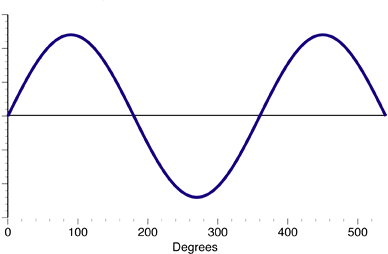
You might remember the sine function from high-school trigonometry. In a right triangle (above), it’s the ratio of the length of the side opposite the angle to the hypotenuse. If you were to chart all of the sines that you got as you went through every angle and then started over again, the result would be a sine wave, which looks like this:
I’ve intentionally left the vertical scale blank. If you were waving your hand, the peaks could be full left and the trough full right. In AC power, the peaks are the maximum positive voltage and the trough the maximum negative. If you were measuring average daily temperatures through a year, the peaks might be the highest daily average and the trough the lowest. The wave can represent any repeating cyclical function, such as the height above the road surface of the air valve on a bicycle tire, the position of an undamped pendulum bob, or the position of a weight moving up and down on an undamped spring.
Due to a characteristic of sine-wave addition, that wave shape may be considered the basic natural shape. But there are clearly many others. There are triangle waves, sawtooth waves, square waves, and video and audio signals, which, except when intentionally made to be sine waves, don’t look sinusoidal at all. So it might be worth considering a square wave as an indication of how it can be created from sines. 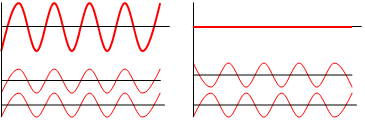
Let’s start with basic addition. In the diagram at the left, two small sine waves of the same frequency and phase (bottom left) add to one bigger wave (upper left). If one of those smaller waves is shifted in phase (starts at a different angle) by an odd multiple of halfway around a circle, the two cancel out, and the result is a flat line. That can be a bad thing (“out of phase” or “reversed polarity” audio) or good (as when phase reversals in so-called “azimuth recording” eliminate interference between adjacent tracks).
Now let’s get a little bit more complicated. 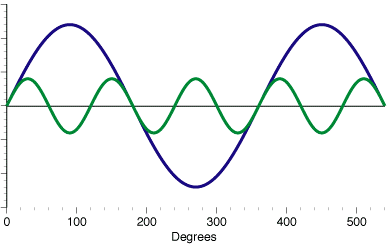 Sine waves that have frequencies that are multiples of the same frequency are called harmonics. The first harmonic (the original frequency) is also called the fundamental. In this example, the fundamental (blue) is the same as before, and there’s a third harmonic at one-third of the amplitude shown in green. If those two are added, the left edge will rise more sharply than before, because both waves increase at that moment. But where the fundamental has a peak the third harmonic has a trough, and the result is a flattening of the fundamental’s peak. The same thing happens to the fundamental’s trough.
Sine waves that have frequencies that are multiples of the same frequency are called harmonics. The first harmonic (the original frequency) is also called the fundamental. In this example, the fundamental (blue) is the same as before, and there’s a third harmonic at one-third of the amplitude shown in green. If those two are added, the left edge will rise more sharply than before, because both waves increase at that moment. But where the fundamental has a peak the third harmonic has a trough, and the result is a flattening of the fundamental’s peak. The same thing happens to the fundamental’s trough.
The result no longer looks like a sine wave. 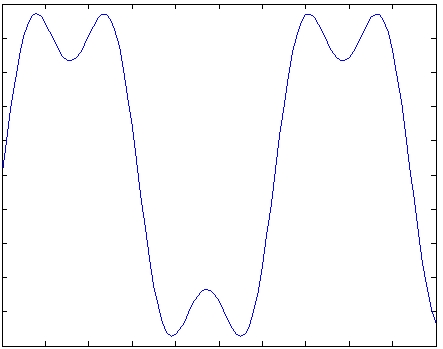
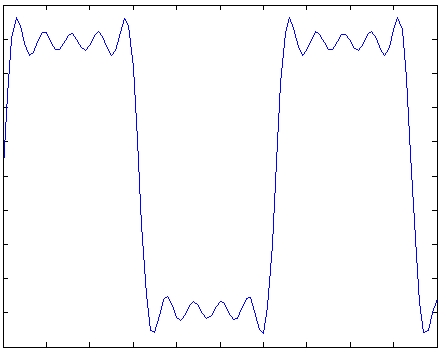 At the left is the result of adding just those two waves. At the right, the fundamental, third harmonic, fifth harmonic, seventh harmonic, and ninth harmonic have all been added together. The result is starting to look more like a square wave. By the time 20 odd harmonics are added, the result, for most purposes, is a square wave. My point is that the edges of a square wave require higher frequencies (fundamental times 41 for the 20th odd harmonic).
At the left is the result of adding just those two waves. At the right, the fundamental, third harmonic, fifth harmonic, seventh harmonic, and ninth harmonic have all been added together. The result is starting to look more like a square wave. By the time 20 odd harmonics are added, the result, for most purposes, is a square wave. My point is that the edges of a square wave require higher frequencies (fundamental times 41 for the 20th odd harmonic).
I hope to explain the implications of this for human visual sensitivity to fine detail very soon. Someday, I hope also to explain some ramifications related to audio distortion. But I’ll close this post with just a little bit (pun intended) about data transmission.
Analog transmission is sometimes said to be like the children’s game Telephone. One child whispers something into another’s ear, the listener interprets it and passes the interpretation into another child’s ear, and so on, until the last child says the last interpretation out loud, and it’s usually a garbled form of the original message. The binary arithmetic used in digital processing, on the other hand, has only two states: on and off, one and zero, high and low, etc. Even a line of children playing Telephone should be able to identify the difference between a whispered one and a whispered zero. 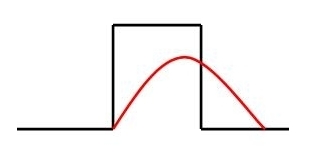
In this diagram, I’ve shown a hypothetical single data bit in black. It rises from zero to one at a particular moment (determined by some sort of clock) and returns from one to zero at the next moment. It’s easily identifiable. But in red I’ve shown what that same pulse might look like after passing through some cable. The cable attenuates high frequencies, and the high frequencies are necessary to maintain the pulse’s edges. The pulse is lower in level, pushed later in time, and spread out. Given that negative-going pulses will be affected the same way, eventually — at some length of that same cable — it will no longer be possible for the equipment at the far end to determine whether a zero or a one has been transmitted.
A signal getting degraded to the point of non-recognition seems more analog than digital. Surprise! The transmission of digital data is an analog process, with varying levels and infinite moments in time. To preserve what seem to be nice sharp edges, beware of processes that might reduce high frequencies.
Tags: amplitude, analog, azimuth recording, digital, distortion, frequency, fundamental, Harmonic, out-of-phase, phase, phase reversal, polarity, sine wave,

No comments yet. You should be kind and add one!
The comments are closed.